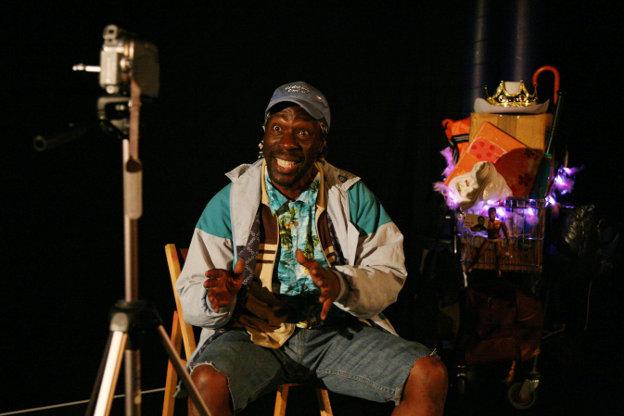A story can be as individual as a person’s home and The Room in the Elephantis an individual’s story about his home and the stories it’s inspired. The first co-production between Òran Mór’s A Play, a Pie and a Pint and Tobacco Factory Theatre, Tom Wainwright’s new play is inspired by graffiti artist Banksy painting THIS LOOKS A BIT LIKE AN ELEPHANT on the side of a formerly abandoned water tank in Los Angeles, turning it immediately into a priceless work of art. The twist is that a man, Tachowa Covington, was living in the water tank, and on 3 March 2011 a legal company called Mint Currency claimed ownership of it and took it away, making the man homeless.
This one-man show, performed by Gary Beadle, tracks the enigmatic story of Covington and how the loss of his water tank home has affected him. The play is at first an exploration of the disparity between the haves and have-nots, taking us through Covington’s story of a lost life and how he found refuge in the water tank that became his home. The simple staging sees Covington, accompanied by a shopping trolley and B, his toy mouse friend, talking to a camcorder on a tripod, telling his story to YouTube the way he wants to tell it. ‘It’s the truth, but events may have changed!’ Covington takes us through the conversion of the water tank into a living space: the installation of a small TV to watch movies on (lots of movies), drapes, a desk – all the trappings of a home that we already know has been taken away. In this way the piece cleverly creates immediate sympathy, tying us to Covington and causing us to side with him against the faceless corporation that seized his home for their own profit.
Beadle brilliantly creates a wide-eyed and unsettled Covington, an engaging and layered character that quickly establishes a rapport with the audience through his lovable eccentricity. Wainwright’s play relies upon the physically distinct performance that Beadle creates: without it the piece would lose its veracity and the connection the audience feels with Covington would weaken. At the beginning Covington exclusively addresses the camera and the performance has a focused intensity to it, the camera acting as another character and giving Covington a reason to talk.
As the play opens out beyond the camera it loses this clarity of focus, meandering between themes of dispossession and the impact that art has upon its subjects. The audience gains a connection to Covington as he addresses them more directly, as if they are the camera, but the script loses its edge as new ideas are introduced. Covington accuses artists of using him for story material, accuses Banksy for potentially knowing what harm his graffiti would cause, and accuses Wainwright for exploiting his story in creating the very play we’re watching. He asks what rights do artists have to disrupt people’s lives, even in the smallest of ways – ways that the artist can never predict. These intriguing ideas are touched on but leave a slightly confused impression as to what direction the play is taking. This confusion can reflect Covington’s own confused and tangential mind, but makes the middle of the play feel slightly lost and unfocused as the larger ideas of homelessness, dispossession, art, and vampiric storytelling all wrestle for Covington’s and our attention.
Òran Mór and A Play, a Pie and a Pint are a regular duo in Scotland, and commission more new plays than anywhere else in the UK, with 37 turned out in a year. With The Room in the Elephant they and the Tobacco Factory Theatre have produced a funny and touching production, with a particularly strong one-man performance. Beadle’s portrayal of Covington is a joy to watch, and his incomplete ramblings and light-hearted comments on losing his unique home are tinged with a deep sadness as he smiles through the tragedy of his repeated homelessness and the loss of the friend and refuge that was the water tank that looks a bit like an elephant.


